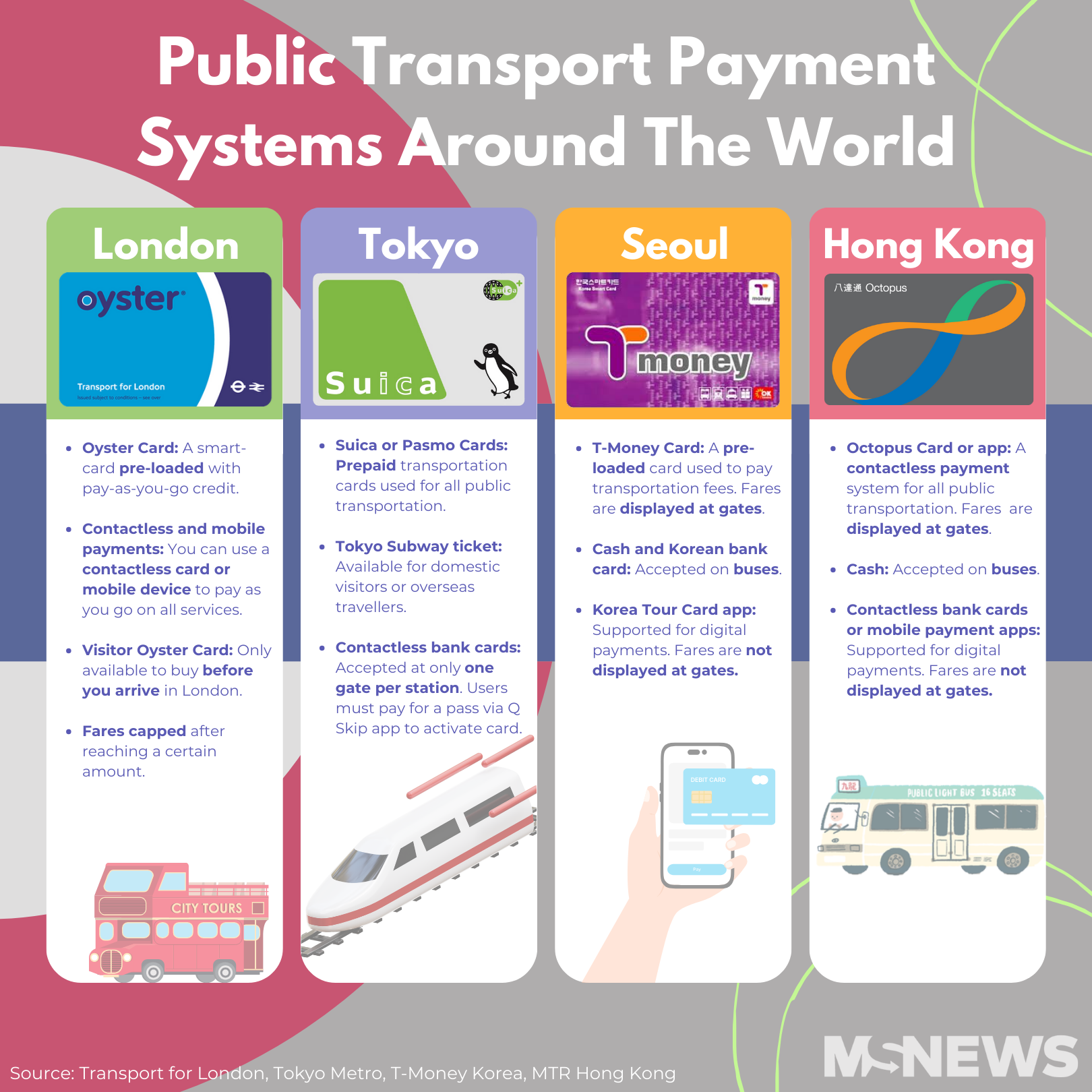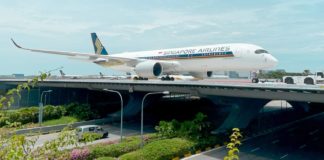MS News Takes A Look At Public Transport Systems Around The World & How They Compare To Singapore
This piece is part of MS Explains, a segment where we provide clarity to common or key topics, making them easier to digest.
The SimplyGo Saga has taken Singapore by storm.
The latest development, following a series of events that happened in quick succession, has the Singapore authorities reversing an earlier decision to phase out its current card-based ticketing (CBT) system.
The Government was planning on a full transition to SimplyGo, an account-based ticketing (ABT) system, but has since stated that it would retain the old system until at least 2030.
Both systems will run concurrently; meanwhile, the Land Transport Authority (LTA) has been tasked with improving SimplyGo’s features, such as displaying fare deductions and card balance information at station gates and bus card readers.
MS News decided to take a look at public transport systems around the world to assess their ticketing schemes and how we compare.

Singapore’s public transport compared to other cities
The four cities we looked at were London, Hong Kong, Seoul, and Tokyo.
Experts MS News spoke to said there was a global shift towards ABT systems in recent years, and this can be seen in the widespread use of account-based wallets such as digital payment apps as well as direct debit.
Singapore is actually relatively advanced in this aspect, according to Terence Fan, an Assistant Professor of Strategy & Entrepreneurship (Education) at the Singapore Management University (SMU).
For example, Hong Kong only introduced Visa payments on its Mass Transit Railway (MTR) in December last year.
Some other cities such as London, however, have sidestepped the fare problem entirely by implementing a fare cap that eliminates the need to view your fare at all when on the go.
Octopus still reigns in Hong Kong, but contactless bank cards have arrived
The long-standing Octopus card, launched in 1997, is still the most popular form of payment when it comes to public transport in Hong Kong.
Besides the physical card, there’s also an Octopus app for tourists, who can instantly add the Octopus to their iPhone or Apple Watch.
However, from December 2023, contactless bank card payments, namely Visa cards, can be used on the city’s MTR system.
“In the first phase, Visa’s contactless credit cards or debit cards are accepted for paying MTR fares,” the MTR announced last year.
“More card options will be available in the second phase of service to be launched in the third quarter of 2024.”
Like SimplyGo, users cannot view fares at gantries when they pay via contactless bank cards at the MTR. Conversely, the Octopus card allows commuters to do so.
There are two different types of fare gates at the MTR — gantries that allow payment by bank cards are wrapped in blue, while those with yellow card readers are for Octopus cards.

Source: Executive Traveller
The city has plans to upgrade some 2,400 fare gates to support multiple payment options, as part of a HK$1.3 billion long-term renewal plan.
London allowed contactless bank card usage for public transport since 2012
In London, commuters have been able to use contactless bank cards alongside the Oyster card since December 2012.

Source: Rail Technology Magazine
“More than 2.5 billion bus journeys have been made using pay as you go with a contactless bank card, mobile or smart watch,” according to Mastercard.
Fares are capped so that they don’t exceed a certain amount – equal to the cost of a pre-paid day/week travel card.
According to Transport for London (TfL): “You can make as many journeys as you like and when all your fares add up to a certain amount, we won’t charge you more and your fare is automatically capped.”
This ensures that fares won’t become excessive for the consumer.
Relating back to the SimplyGo backlash, Associate Professor Walter Theseira told MS News that a fare cap implementation would render it unnecessary to view your fare when tapping in and out of a gantry.
In 2021, TfL had promised that the Oyster would not be discontinued completely.
However, in 2022, the transport authority said it is planning to integrate its Oyster transit card into an account-based ticketing system for contactless fare payments.

Source: BBC
TfL said: “This is likely to be a proof of concept involving design and back-office development work, which we will lead on [and] involve significant upgrade to our retail assets, changes to the reader to support the new risk management models, changes to the RID software as well as decommissioning the legacy Oyster system.”
According to The Stack, it was searching for a new revenue collection system operator that will transition card-based Oyster into the account-based ticketing system.
At the time of writing, the card-based Oyster is still in use.
Mobile and cashless options abound in Seoul
In Seoul, you can use contactless-enabled bank cards, rechargeable T-money public transport cards, and single-use tickets to pay for your rides. The contactless payment system also supports alternative digital payments such as the T-money mobile app and Samsung Pay.
Account-based payment systems are by and large only available for local residents. They can use a public transport payment-enabled card at Korean banks.
Tourists can only use either the T-money pre-paid card or the mobile Korea Tour Card — both of which are easy to obtain and use.
The former will display fares at the gate, while the latter doesn’t. However, the Korea Tour Card app allows commuters to manage fares and make top-ups using credit or debit cards.
Tokyo slow to adopt but gradually changing
Currently in Tokyo, card-based transportation payment modes such as Suica or Pasmo cards are most suitable for public transport travel. Transport gates still largely support these older cards.
However, there is a shortage of semiconductors and new physical cards have been unavailable since Jun 2023, according to the Tokyo Metropolitan Bureau of Transportation.
Implementation of contactless bank cards is still in its early stages. Only one gate at stations supports the pass system and you have to activate your card by paying for a pass via the Q Skip app.
This makes things less simple than the tap-and-go method applicable to SimplyGo.
Certain subway lines in Tokyo, such as the Denentoshi Line, operated by Tokyo Railways Co, allow for the use of contactless bank cards.
As with other account-based payment systems, there’s a slight delay in processing the fare display.
According to a Visa public relations official, it takes about 0.3 seconds for its payments to complete a cashless bank transaction at a fare gate.
As implementation is still in its early stages, card-based transportation payment modes would still be more suitable for travel — albeit, they have a limit of ¥20,000 (S$181.84).
Though you can’t top up a physical Suica or Pasmo card with a credit card at a ticketing machine, you can add a virtual Suica or Pasmo card to your iOS smartphone and do top-ups using credit cards easily.
Account-based systems allow for much greater versatility and choice, says experts
Experts MS News spoke to note that there are advantages to the ABT system, and one in particular said other countries are following “exactly the same trajectory” as Singapore in terms of public transport payments.
“The cashcard concept itself is reaching the end of life in general, given widespread use of account-based wallets or direct debit,” said Associate Professor Walter Theseira, head of urban transportation programme at the Singapore University of Social Sciences.
The main difference between these systems is that the cash is no longer stored on the physical card.
ABT systems are “open loop”, meaning it allows for the storage of information outside of the user’s card and permits the use of various devices for payment. CBT systems are “closed loop”, meaning information is stored on the card and its loss would mean a loss of all information on the card.
Assistant Professor Fan concurred, noting that with account-based systems, commuters no longer need to have a transit-dedicated card.
“Credit or debit cards, or digital wallets that commuters already use for other purchases, can be used directly, eliminating the need for commuters to queue up to get a new or replacement card,” he said.

However, Assistant Professor Fan noted that because these cards are controlled by financial institutions rather than LTA, it takes time to retrieve their remaining balance.
Thus, to avoid slowing down commuters, authorities have decided not to show the fares.
Singapore, he added, has been relatively advanced on the move to a CBT system.
“Other countries, such as Japan, still have transport lines that use only the old, card-based system, and do not allow credit or debit cards to be used directly at [most] transport gantries,” he said.
That’s because there are costs in updating all the existing infrastructure, he added.
“Going forward, account-based ticketing allows more flexible forms of payment, and is therefore more versatile than the old, card-based system.”
New payment systems will no longer be cash-based
Associate Professor Theseira agreed that the world, not just Singapore, is already moving away from cash-based systems and towards an account-based payment system.
“In general, nobody today launches a new payment system based on a cash card due to that constraint, and even for existing ones that are widely used like Japan’s Suica, it is unclear if they will remain competitive compared to the current wave of account based digital wallets,” Associate Professor Theseira said.
Account-based systems also allow for better scaling and innovation, he noted.
An example he cited was the ability to look at a wider range of travel history for the purpose of computing or capping fares, as is the case in London where there are fare caps, which prevent public transport expenses from rising beyond a set level per account.
“With cash cards, it is the card itself that must be of a special type to be recognised for a subsidy, and this is not flexible.”
Associate Professor Theseira also believes that cash card payment systems are a sunset technology. “Why keep money on a specific card that can be lost, and can only be used in places where there is specialised hardware to read it and credit to it?” he asked.
That said, he feels that a purely ABT public transport system in Singapore would not be well-received right now, “given the strong preference many commuters have for reading the fare information and balance instantly”.
He has also observed that “a significant minority of commuters appear to have some distrust of the idea of ABT, in the sense that they are not confident such a system charges fares correctly or is transparent.”
There is hence a need to address these trust and transparency issues before Singapore can consider phasing out the current cash-based system, Associate Professor Theseira concluded.
Improvements on the way for SimplyGo, no current plans to sunset EZ-Link until at least 2030
In a statement on 26 Jan, Transport Minister Chee Hong Tat said that he has tasked LTA to improve SimplyGo’s features.
This includes displaying the fare when commuters tap out of buses or train stations.
Mr Chee has also promised that the current CBT system will be around till at least 2030, after which the authorities will decide whether to continue with it.
But before the authorities can take a decision, it will have to improve its framing of SimplyGo as a better option compared to existing forms of payment, and solve the fare transparency issue.
Or perhaps, as other countries show, both systems can co-exist. For now.
Have news you must share? Get in touch with us via email at news@mustsharenews.com.
Featured image adapted from Pxhere.

Drop us your email so you won't miss the latest news.









